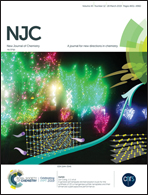An amide probe as a selective Al3+ and Fe3+ sensor inside the HeLa and a549 cell lines: Pictet–Spengler reaction for the rapid detection of tryptophan amino acid†
Abstract
In the present study, an amide-based chemosensor L is reported for the selective determination of tri-positive Al3+ and Fe3+ metal ions via the fluorescence (FL) “turn-on” state. L can be further used as an Al3+ ion sensor in live cells with a significant emission at 430 nm. The receptor showed high binding affinities of 1.045 × 105 and 6.234 × 105 M−1 for Al3+ and Fe3+, respectively. Furthermore, the chemosensor L also specifically senses tryptophan (Trp) upon the introduction of various amino acids. ESI-MS data and spectroscopic studies indicate a probable intermediate formation through the Pictet–Spengler reaction between amide L and Trp. Trp can be also recognized as a FL quencher in the presence of L + Al3+ in an aqueous solution. A PET-based mechanism is proposed for the FL enhancement upon complexation, which is further supported by DFT calculations. Tryptophan, which is the main counterpart of BSA, can be introduced as a real sample to verify the selective PL quenching response. The receptor provides an LOD response of 2.43 × 10−7 M for the Trp amino acid, suggesting the practical application of tryptophan detection in an aqueous medium for any biological sample.



 Please wait while we load your content...
Please wait while we load your content...